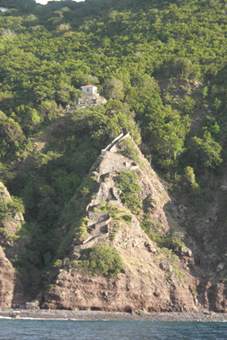17:37.98N 63:15.50W
28th January 2012 - Ladder Bay,
Saba
Originally, we had intended that Antigua would be the
northernmost island in our Caribbean voyaging
but that plan changed when we encountered auxiliary generator problems and it
appeared that Sint Maarten was the most likely place to have them fixed. Having been in Simpson Bay Lagoon for
just over a week and with the necessary repairs carried out we headed south for
the tiny island of
Saba. The passage was a tad uncomfortable as
the wind was right behind us and the swell caused us to roll, pitch and yaw
seemingly simultaneously.
We had been warned that Saba was a
difficult island on which to land and this proved to be the case. Because it’s tiny it provides very
little lee anywhere and funnels the wind down its shores. We picked up a mooring off the main
harbour on the south side of the island with the wind gusting a good 25 knots
and the seas heaving around us. Jon
went ashore in the dinghy to deal with the formalities and rather a wet, bumpy
ride it proved to be in an Avon Redcrest rub-a-dub powered by 3.3HP
outboard. The three different
authorities with which one has to deal are housed in two separate portakabins
and a small harbour office – a million miles from the smart new customs and
immigration building in Sint Maarten.
On the other hand, they were much more pleased to see us and made the
process a great deal easier and cheaper.

The somewhat utilitarian Fort Bay
We then motored the couple of miles round to the west
(leeward) side of the island where it would supposedly be calmer for the
night. It was, a bit, but the NE
wind, having curved round the southern end of the island to become easterly at
Fort
Bay, curved round the
northern end of the island to become northerly on the western shore. That made things very uncomfortable
indeed. Ladder Bay takes its name from 524 winding steps
that, until pretty recently, were the only means of getting anything onto the
island.

The rather more picturesque Ladder Bay and the 524 steps
As planned, we set off the next morning to motor back to Fort Bay (trying
to get ashore at Ladder Bay in these conditions is little short of suicidal) but
the weather gods were not with us again and conditions were even worse than the
day before. As we were preparing to
leave the mooring in Ladder Bay, the rub-a-dub, attached to our stern
took off vertically and nearly drowned the outboard engine. OK; hint taken; off with the engine and
we’ll put it on when we get to Fort Bay.
In the process of trying to drown the engine the rub-a-dub had managed to
shear off one of the silly little rubber mushroom-shaped jobbies on its stern
tube, that hold the plastic frame onto which the outboard is secured. So, no matter what, we were going to be
into jury-rigging the way in which the outboard was attached until we could find
someone to do a proper job. But,
not a major issue provided that you take trouble with your lashings and take it
easy. It was a pretty good idea
removing the engine for the short trip round. The dinghy took off and did one and a
half barrel rolls on the way round there, ending up upside-down. One look at the 30 knot conditions at
Fort
Bay decided it. It was too late to move on to Nevis so
it was back to Ladder Bay.
It was very disappointing not to be able to land as, from what we’d heard
and read, it is a remarkable island populated by some very resilient
people. The island is about 4 miles
square and has only 1,400 inhabitants.
The photographs of the flora and fauna were very exotic and the houses
painted white with red roofs looked delightful.. And who could resist visiting a capital
named “Bottom”? It is
marginally below the only other “town” Windwardside. The brochure Jon was given, which is
clearly a translation from the Dutch, states “As a result of the limited
accessibility of the island, tourists remain small-scaled and of a high quality
level.” Sadly, Saba will have to wait a couple of years for these two
“small-scaled, high quality” visitors to make a second attempt at
landing.


